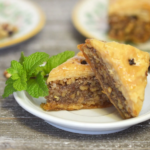How to Make Sourdough Bread Recipe

If you’re the type that likes to get your kitchen filled with the smell of fresh bread, there’s really no better way than baking a sourdough bread recipe from scratch. You may well have heard of it for its tangy flavor and crunchy crust or for how healthier and easier to digest than many other breads. Here, in this extensive guide we will take you through step by step how to make sourdough bread at home in the easiest way possible.
This recipe and guide is for you whether you’ve been baking for years or just begin your sourdough adventure, here’s how to make a delicious, wholesome loaf in your own kitchen.
Why Choose Sourdough Bread?
Sourdough bread is actually literally thousands of years old, we refer back to the natural fermentation process, yet we’re using wild yeast and lactic acid bacteria. This sourdough bread recipe is worth a try, here’s why:
Benefits of Sourdough Bread
- Better Digestibility: Gluten, as well as phytic acid are broken down during the fermentation process making it easier to digest.
- Sourdough boasts of rich flavor: tangy with natural fermentation and chewy texture.
- It is no Commercial Yeast Needed: it uses a sourdough starter instead of active dry yeast.
- Sourdough bread: maintains a longer shelf life, other breads permitting, due to its natural array of acids that resist mold.
- Nutritional Value: Sourdough’s nutrients (B vitamins, iron and magnesium) are more bioavailable.
Source: Healthline on Sourdough Benefits
Ingredients You’ll Need
So here’s the basic recipe for sour dough bread:
For the Starter:
- 1/2 cup (60g) whole wheat flour
- 1/2 cup (60g) all-purpose flour
- 1/2 cup (120ml) filtered water
For the Bread:
- 500g (about 4 cups) bread flour
- 375g (1.5 cups) water
- 100g (1/2 cup) active sourdough starter
- 10g (2 tsp) salt
Step-by-Step: How to Make Sourdough Bread at Home

The full sourdough bread recipe is coming your way so let’s build your starter and then bake that perfect loaf.
1: Make Your Sourdough Starter (Day 1–7)
If you should not have a sourdough starter however, you’ll discover a way to make one. The process takes 5–7 days.
Instructions:
- Put whole wheat flour and filtered water (60g each) into a glass jar and mix equal parts of it.
- Let sit at room temperature covered loosely with a lid or cloth.
- Discard half and fresh flour and water, feed it daily.
- On day 5–7 it should be bubbly, tangy smelling and expand to double size in about 4–6 hours after feeding.
Reference: King Arthur Baking Guide to Sourdough Starters
2: Autolyze the Dough
It hydrates the flour which allows the gluten to begin developing.
- Add 500g bread flour and 375g water, mix until just mixed with no dry flour.
- Leave to sit for 30–45 minutes.
3: Add the Starter and Salt
- Add to the dough 100g your active sourdough starter and 10g salt.
- Let rest with a towel over it while you mix. Or knead by hand, (the dough hook attachment tends to overwork the gluten) or mix for 5 – 7 minutes until elastic in texture.
- Allow to rest in a bowl lightly oiled with the oil from the sausage, for 30 minutes.
4: Bulk Fermentation (4–6 Hours)
During bulk fermentation, the dough ferments and strengthens.
- Place the covered bowl in a room temperature place.
- Do stretch and folds every 30 min the first 2 h.
- Reach up and pull one side of the dough toward you and fold that over.
- Repeat 3 more times, rotate bowl and repeat.
- Allow it to rise until it has doubled in size, either 50–75%.
5: Shaping the Dough
- Dust lightly your surface and shape the dough into ball.
- Bench rest it 20 minutes.
- Sink it back into a tighter ball which you can place into the proofing bowl or basket (lined with a towel).
6: Final Proof (Overnight in Fridge)
- Refrigerate overnight (8–12 hours), cover the dough.
- It makes the bread better tasting and better textured.
7: Score and Bake
- Place Dutch oven, with lid on, in a cold oven. Preheat to 475°F (245°C).
- Transfer the dough to parchment paper and top with a sharp razor or lame and score.
- Bake covered with lid in the hot Dutch oven, place it:
- With lid on, 20 minutes.
- Remove lid, 20–25 minutes until golden brown.
- For at least 1 hour, let cool on a wire rack before slicing.
Tips for a Perfect Sourdough Bread Recipe
- Use Filtered Water: Chlorinated tap water can inhibit fermentation.
- Weigh Ingredients: Use a digital scale for accuracy.
- Use a Dutch Oven: Creates steam for a crispy crust.
- Don’t Rush Proofing: Longer, cooler fermentation builds better flavor.
- Keep a Starter Feeding Schedule: Feed every 12 hours when active.
Common Troubleshooting
| Issue | Solution |
| Flat loaf | Dough was over-proofed or under-shaped |
| Dense texture | Starter not active enough or under-fermented dough |
| Pale crust | Oven not hot enough or removed too early |
| Sour flavor too strong | Over-fermented dough or over-ripe starter |
Storing Your Homemade Sourdough
- Keep at room temperature in a paper bag for up to 3 days.
- For longer storage (up to 2 months) instantly refreeze in an airtight bag.
- Don’t refrigerate the bread, it dries it out faster.
Ingredient Breakdown and Their Benefits
Bread Flour
Sourdough is gluten structure and high protein content (12–14%) chewy.
Sourdough Starter
Gives really great natural yeast for flavor and leavening.
Water
Acts as a hydrator of dough, activates enzymes and controls dough consistency.
Salt
Also, not only enhances the flavor, but it will make gluten stronger and slows the fermentation.
Sourdough Bread Recipe Variations
- Whole Wheat Sourdough – Substitute 30–50% of bread flour with whole wheat for a nutty taste.
- Seeded Sourdough – Add sunflower, flax, or sesame seeds for extra crunch.
- Rye Sourdough – Replace 20–40% flour with rye for a denser loaf with rich flavor.
Reference: The Perfect Loaf on Sourdough Variations
Health Benefits of Sourdough Bread
- Lower Glycemic Index: Slower blood sugar rise compared to white bread.
- Prebiotic effects: Natural fermentation promotes gut health.
- Fewer Preservatives: Made with simple, wholesome ingredients.
Source: WebMD on Sourdough Nutrition
FAQs: Sourdough Bread Recipe

Q: How do I know my sourdough starter is ready?
If it’s healthy, it will double in size within 4–6 hours of feeding and smell bubbly with a mild tangy smell.
Q: Can I use whole wheat flour for everything?
A: It does work but it soaks up more water and makes denser loaves—add to bread flour for best results.
Q: What is the best time to bake after proofing?
A: Fresh out of the fridge—the dough is easier to score and also holds shape better.
Q: Can I skip the overnight proof?
A: Not recommended. It creates flavor and improves texture if proofed overnight.
Final Thoughts
There’s nothing like learning to execute the sourdough bread recipe at home – it’s so rewarding and therapeutic, too. Learning how to make artisan quality bread is an easy process that involves cultivating your own starter and pulling that perfect golden crusty loaf right out of your oven.
If you follow this guide, you won’t only bake a good loaf of sourdough, but you’ll learn to love the art of baking sourdough. Your homemade sourdough, whatever you fill it with (whether it’s eaten fresh with butter or toasted with avocado) will be a centerpiece at your table.
Reference Links (High DA Sources)
- King Arthur Baking – Sourdough Guide
- Healthline – Sourdough Bread Nutrition
- WebMD – Sourdough Bread Benefits
- The Perfect Loaf – Artisan Sourdough Blog
- Cultures for Health – Sourdough Basics
🔗 The link for more delicious and easy to make recipes are also on our website!
- How to Make Alfredo Sauce Recipe at Home

- Top Trending Recipes in Pakistan 2025 for Dinner

- How to Make an Old Fashioned Cocktail at Home: A Step-by-Step Guide

- How to Make a Spicy Chocolate Chip Cookie Recipe: A Fiery Twist on a Classic Treat

- How to Make Spicy Best Beef Stew Recipe A Flavorful Journey for Spicy Food Lovers

- How to Make Sashimi at Home: Easy Step-by-Step Guide

- How to Make Miso Soup at Home: A Step-by-Step Guide for a Delicious and Healthy Meal

- How to Make Baklava at Home: Easy Step-by-Step Guide

- How to Make Paella at Home: A Detailed Step-by-Step Guide



